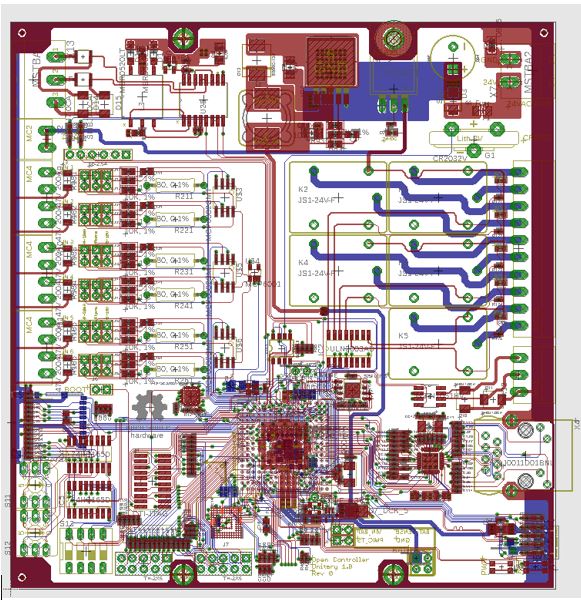|
December 2018
AutomatedBuildings.com
|
[an error occurred while processing this directive]
(Click
Message to Learn More)
|

When
you read through this whole series of articles you may ask:
- Why are you telling me what’s inside a controller? Should I care?
- Can’t I just buy a controller and use it? Are you telling me I
should
make one for myself?
Not
necessarily. Although if you wanted to make your own controller, you
could. The reality is, none of these devices contain any parts that are
truly proprietary or unavailable to the public. At least not anymore.
Most modern DDC controllers are composed of parts that are off-the-shelf
items. Many of the various bits and pieces of these devices can
be found in singles from large online retailers such as Digikey or Mouser. Components,
boards, sub-assemblies, and starter kits can be found on hobbyist sites
such as Adafruit
and Sparkfun.
Sample and low-volume prototype printed circuit boards can be
inexpensively fabricated from places like OSH Park or Macrofab. It turns
out that it’s completely possible to build your own edge controllers.
Not only that, but it’s also possible to buy just enough pieces to make
just one controller; if you
are so inclined.
This
is kind of a big deal. In the past, someone with a passing interest in
electronics could not very easily experiment with these types of
devices. They would have to commit to buying thousands of units as
opposed to purchasing just one chip. Access to datasheets and reference
manuals needed for evaluation and design required extensive legal
agreements and signing of non-disclosure forms. Software and tools to
compile, flash, and test various processors were often extremely
proprietary, difficult to use, and prohibitively expensive (like
thousands of dollars). These pricey development tools were of course
not cross-compatible with other vendor’s chips. It was not very easy to
test out and learn about products from different manufacturers.
All
of these concerns have largely disappeared in the past decade. Many of
the barriers to entry have been removed by several of these parts
vendors. They have done this to make it easier for someone with a great
idea to be able to evaluate and choose their chip to use in a new
product. To make it even easier, most companies offer low-cost development boards for accessing a particular
chip’s features much faster. The wide availability of these open
components and supporting tools has enabled the growth of a movement in
the electronics world. This is sometimes referred to the Maker Movement.
However,
this series is not meant to be a how-to on building electronics for
control. There are plenty of such resources already in books or online.
The purpose of these articles is more of an architectural tour. The
control devices that we will inevitably be installing in our buildings
will be by necessity open-source, open-architecture, and extensible. It
will become important to become familiar with the overall layout of
these new systems so that the controls industry can be streamlined when
entering this new era. Someone doesn’t have to be a professional
hardware or software developer to be able to appreciate electronics and
software. Just like someone can study building architecture without
being involved in the construction industry. With the introduction of
newer, powerful, and cost-effective embedded microprocessors, much of
the tasks usually performed by global controllers, gateways, or BMS
servers will be pushed out to the edge; to the field devices actually
controlling and monitoring equipment. What’s needed is an understanding
of what edge controllers can do and should be required to do. By
studying edge controller architecture, one can develop an understanding
of what should go where.

These are completely self-contained
personal computers
The
Processor
Until now the question of what data and processing activity should go
where was easy to answer. Field devices have to be low-cost products.
In the past, it was only cost-effective for field controllers to be
constructed using microcontrollers as the central component. These
simple devices are limited in processing and storage capability.
Because a microcontroller can do only a few things at once, that meant
it would only run the DDC program for the equipment it’s attached to,
and usually nothing else. Just a little bit of processing and data went
into the controller; in many cases not even occupancy schedules or
historical trends. All of that stuff normally went into a global
controller or gateway/router. The schedules and histories would more
easily be hosted there. But the vast majority of everything else went
into the server, which is usually a desktop PC sitting on a folding
table in the boiler room. In the era of edge control, everything has
changed. That desktop PC now exists on a single piece of silicon, and
its location is in the controller for every single zone.
[an error occurred while processing this directive]
The Hardware
Board peripherals and controller form factor continues to be an
important consideration. At the end of the day, having a complete
personal computer on a chip is totally useless unless it’s connected to
interact with the actual equipment we care about. Increasingly new
controller products are being equipped with IP connectivity. Will we
continue to see controllers daisy-chained together using serial ports?
BMS network topology is destined for an inevitable overhaul. Will
features such as PoE and Wireless help alleviate some concerns about
installation costs? The most important issue for controls contractors
is the installation workflow and device commissioning. How will we
tackle the task of assigning IP addresses and commissioning hundreds of
devices as opposed to doing just a few? Some things will probably
remain constant, however. The way I/O is done will probably remain the
same, but improvements can be made by standardizing how these points
are brought into the system. For example, creating a uniform and
streamlined way for I/O read-writes through OS kernel system calls. The
underlying infrastructure in embedded Linux already exists to support
this.
The Software
Finally, a discussion on platform software/firmware and User
Applications. The reason for all of this focus on hardware is to
guarantee support for all of the applications that will run on these
devices, both at present, and in the future. Solid hardware is the
foundation that future BMS applications will be built upon. One of the
main reasons to transition from single-threaded devices using
microcontrollers to multi-threaded operating systems is to future-proof
these devices (at least as much as possible). Future controllers will
still need to run DDC programs reliably and in real-time.
In addition
to doing what they always have done, these products will have to manage
other processes without failing in their main purpose. They will have
to do this in a secure manner and be capable of being upgraded/updated.
So, if you are interested in what goes inside an edge controller, stay
tuned as we will explore each of these three topics in depth, starting
next month with The Processor.
footer
[an error occurred while processing this directive]
[Click Banner To Learn More]
[Home Page] [The
Automator] [About] [Subscribe
] [Contact
Us]
